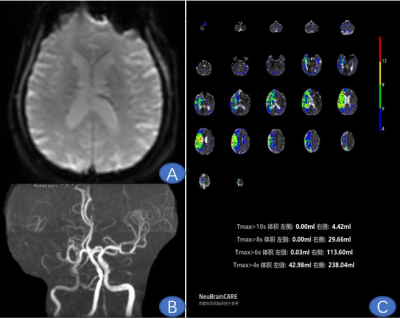4137
Integrating clinical and imaging features to predict recurrence of cerebrovascular events —— A machine learning study1Chinese PLA General Hospital, BeiJing, China, 2Chinese PLA General Hospital, beijing, China
Synopsis
Stroke is characterized by a high recurrence rate, and intervention after early identification of patients at risk of recurrence may improve their prognosis. After strict screening, 55 patients were enrolled in this study. the results show that it is feasible to identify patients with recurrent cerebrovascular events within one year by integrating clinical and imaging features through machine learning. RandomForest and NaiveBayes are the optimal algorithms, and HCR(hypoperfusion cubage ratio)can significantly optimize the recognition of these patients.
Background and Purpose
A large number of clinical and imaging variables are obtained when describing patients with chronic ischemic stroke, and the numerous available predictors maintain intrinsic complex interrelations. We propose a new imaging index, HCR (Hypoperfusion Cubage Ratio), The purpose of this study is to determine the effect of HCR on recurrence stroke and to predict the clinical prognosis of chronic ischemic stroke patients with anterior circulation macrovascular occlusion by integrating clinical and multimodal imaging features and selecting an appropriate mathematical model.Methods
A consecutive series of 187 patients with chronic ischemic stroke and large vessel occlusion in the anterior circulation who underwent magnetic resonance examination between January 2015 to December 2018 was analyzed, and 55 patients were strictly selected who underwent multimodal imaging examination and were followed up in the later stage.Lesion volumes were determined with the post-processing software by diffusion-weighted magnetic resonance imaging(DWI) and perfusion-weighted imaging(PWI). HIR was defined as the ratio of lesion volume between TMax > 10s and Tmax > 6s, Similarly,HCR was defined as the ratio of lesion volume between TMax > 6s and Tmax > 4s. The collateral blood flow was evaluated by arterial spin labelling (ASL) with postlabelling delay (PLD) of 1.5 and 2.5s, which was divided into 0-4 grades from bad to good. The FLAIR vascular hyperintensity(FVH) score was ranged from 0 (no FVH) to 7 (FVHs abutting all ASPECTS cortical areas). The machine learning method based on information gain implements the feature selection of 20 clinical and imaging variables to consider the contribution of variables to posterior modeling, and expressed in information gain (entropy) ranking (IGR). Then integrates them with five common algorithms(RandomForest, LogitBoost, Logistic, NaiveBayes and Bagging). The optimal algorithm based on accuracy and an area under the receiver operating characteristics curve(AUC) is selected to identify patients with recurrent cerebrovascular events within one year.Results
After feature selection, 11 variables were included in the study, and the first three variables with greater contribution were HCR (IGR=0.2688), mRS on admission (IGR=0.2030) and diabetes history (IGR=0.0446). FVH score and collateral circulation grade had no significant contribution to recurrent stroke(IGR=0). Then it was divided into model A and model B according to whether the HCR is included or not. After ten-fold cross-validation policy, model A showed that when identifying patients with recurrent cerebrovascular disease, the optimal algorithms were RandomForest (accuracy = 0.836, AUC=0.903, AUC is the maximum) and NaiveBayes (accuracy = 0.855, AUC=0.853, accuracy is the maximum) which hasn’t significant difference, but there were significant differences in accuracy and AUC between them and other algorithms(p<0.05). In addition, there were significant differences between model A and model B after RandomForest and NaiveBayes calculation (p<0.05).Conclusions
This study believes that integrating clinical and imaging features through machine learning is feasible and applicable in identifying patients with recurrent cerebrovascular events within one year, and RandomForest and NaiveBayes are the optimal algorithms. Moreover, a new imaging index is proposed and its important role in evaluating recurrence stroke is verified, which can significantly optimize the identification of this kind of patients.Acknowledgements
No acknowledgement found.References
1.Brugnara G, Neuberger U, Mahmutoglu MA, Foltyn M, Herweh C, Nagel S, Schönenberger S, Heiland S, Ulfert C, Ringleb PA, Bendszus M, Möhlenbruch MA, Pfaff JAR, Vollmuth P. Multimodal Predictive Modeling of Endovascular Treatment Outcome for Acute Ischemic Stroke Using Machine-Learning. Stroke. 2020 Dec;51(12):3541-3551.
2.Juarez-Orozco LE, Knol RJJ, Sanchez-Catasus CA, Martinez-Manzanera O, van der Zant FM, Knuuti J. Machine learning in the integration of simple variables for identifying patients with myocardial ischemia. J Nucl Cardiol. 2020 Feb;27(1):147-155.
3.Calvillo-Argüelles O, Sierra-Fernández CR, Padilla-Ibarra J, Rodriguez-Zanella H, Balderas-Muñoz K, Arias-Mendoza MA, Martínez-Sánchez C, Selmen-Chattaj S, Dominguez-Mendez BE, van der Harst P, Juarez-Orozco LE. Integrating the STOP-BANG Score and Clinical Data to Predict Cardiovascular Events After Infarction: A Machine Learning Study. Chest. 2020 Oct;158(4):1669-1679.
Figures


